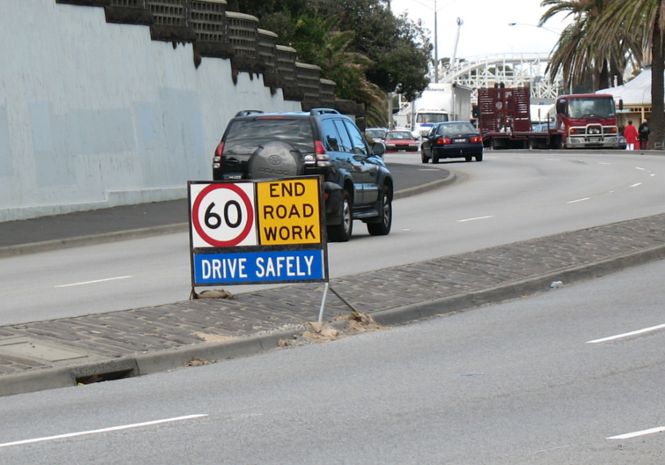Part Three
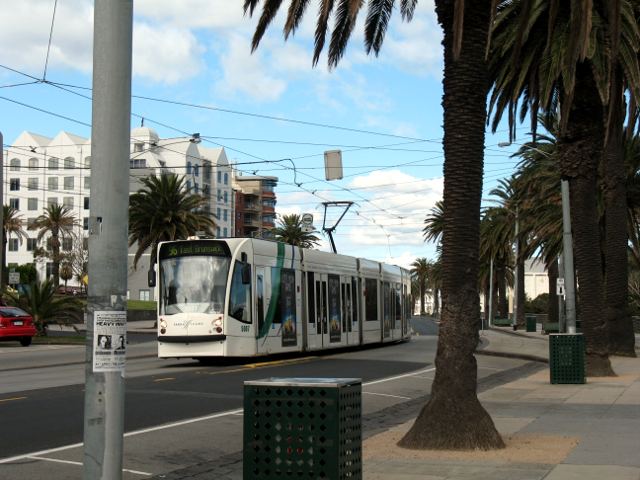 At this point, I have to admit that, in this
narrative, it may seem as though Melbourne is not getting as much
attention as the other places. That's because we didn't have a car in
Melbourne. We took the trams (streetcars) everywhere we wanted. So,
for MTR, there may not be all that much interest. For us, Melbourne
was a delight. We spent four days there and could easily have spent
fourteen. The neighborhoods reminded us of San Francisco, without the
homeless panhandlers (though with the graffiti in some areas). We went
out to St Kilda Pier, saw the entrance to Luna Park, and saw the view of
the city skyline from the pier. We ate great food. We saw what perhaps
is the best fast-food restaurant name ever: Lord of the Fries. We
shopped. We went to the local auto club affiliate, the RACV, and got
more maps.
At this point, I have to admit that, in this
narrative, it may seem as though Melbourne is not getting as much
attention as the other places. That's because we didn't have a car in
Melbourne. We took the trams (streetcars) everywhere we wanted. So,
for MTR, there may not be all that much interest. For us, Melbourne
was a delight. We spent four days there and could easily have spent
fourteen. The neighborhoods reminded us of San Francisco, without the
homeless panhandlers (though with the graffiti in some areas). We went
out to St Kilda Pier, saw the entrance to Luna Park, and saw the view of
the city skyline from the pier. We ate great food. We saw what perhaps
is the best fast-food restaurant name ever: Lord of the Fries. We
shopped. We went to the local auto club affiliate, the RACV, and got
more maps.
It appears that each state's auto club gets its maps from different sources. I couldn't identify the source of the NRMA's maps, perhaps its own cartographic department; the RAC in WA did its own cartography; the RACV appeared to source maps from UBD.
At the city museum of Melbourne, small yet elegant and providing a great window into the city's list, the woman at the front desk asked, "Postcode?" Then she heard me talking with my drawling Midwestern accent and asked which state in the U.S. We said "California" and, as it turned out, she had visited Minnesota often with her American ex-husband and had several choice things to say about Minnesota which I, as a former Iowan, found amusing.
Back to the trams: they're excellent. Even though privatized, they were still efficient, frequent, and well-cared-for. We went to the 7-Eleven near our hotel every day to buy our A$6.80 daily passes, going anywhere we wanted. There's even some private right-of-way in the system: for example, at the Melbourne Zoo.
The zoo was where we finally got to see some Australian wildlife close-up; including kangaroos, of course; koalas, still lethargic; a platypus, surprisingly hyper and active as they swim continuously in circles (the Australian 20-cent coin even tries to represent that in its depiction of the animal); and the other egg-laying mammal, the echidna.
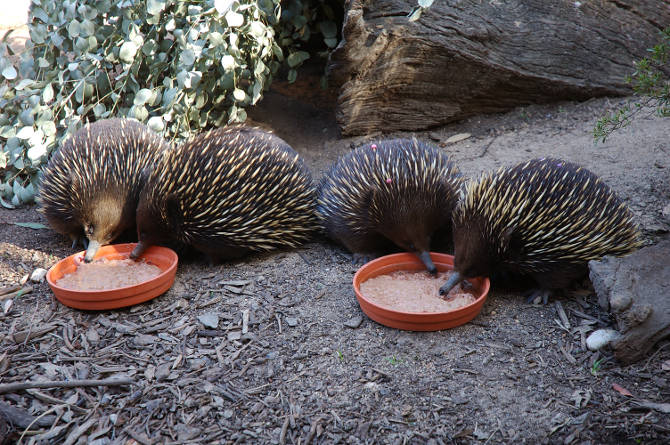
The echidnas are fascinating in their own way. The zoo kept them in with the koalas, no doubt assuming that the koalas wouldn't hurt anything since they might actually have to expend some energy to do so. Koala feeding time was also echidna feeding time. The zookeepers put out bowls of an orange-ish looking mush -- Echidna Chow? -- and explained that echidnas eat ants in the wild, but they like this stuff much better. And, sure enough, the echidnas may be primitive but they're not stupid. Four of them crawled out of a hollow log that seemed to be the size of one of them. They waddled up to their bowls and started lapping up the orange stuff with their snouts. Echidnas also show up on Australian money: they are shown on the 5-cent coin in a somewhat stylized fashion.
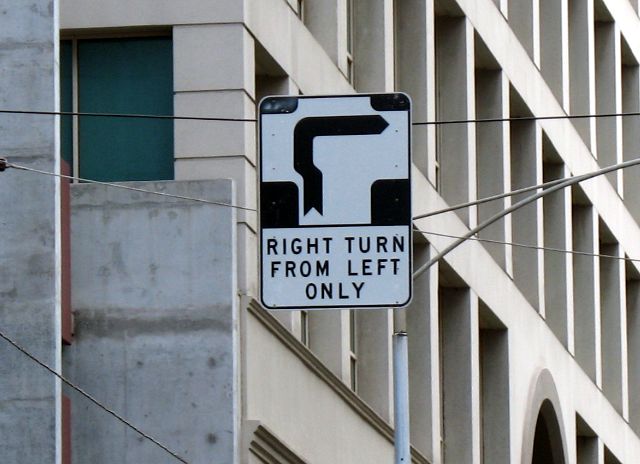 When we go back to Melbourne, and the operative word is "when", we would
like to go into the surrounding areas. We didn't rent a car in part
because we didn't need one and, in part, because Melbourne traffic is a
complex mix of cars and trams. There's the unique "hook turn" on streets
where there are trams. If you want to turn right at an intersection from a
street where there is a tram track, you first have to pull all the way to
the LEFT, and wait until oncoming traffic clears. Only then can you turn
right. The American equivalent would be to make a left turn by pulling
over all the way to the right, waiting until oncoming traffic clears,
and then turning left from that right-hand lane. From my description,
you might think it doesn't work, but it does.
When we go back to Melbourne, and the operative word is "when", we would
like to go into the surrounding areas. We didn't rent a car in part
because we didn't need one and, in part, because Melbourne traffic is a
complex mix of cars and trams. There's the unique "hook turn" on streets
where there are trams. If you want to turn right at an intersection from a
street where there is a tram track, you first have to pull all the way to
the LEFT, and wait until oncoming traffic clears. Only then can you turn
right. The American equivalent would be to make a left turn by pulling
over all the way to the right, waiting until oncoming traffic clears,
and then turning left from that right-hand lane. From my description,
you might think it doesn't work, but it does.
Again, I'd go back to Melbourne any time I could. The weather could have been a little better -- we missed a heat wave and it had become abnormally cool and rainy instead on a couple of days -- but the city more than shone through. I wish I had a chance to explore the neighborhoods some more. The newspaper, The Age, seemed to be the best, or at least the most cosmopolitan, in Australia. If you're a fan of Rupert Murdoch's tabloids, though, don't worry: Melbourne's got one of those. There's a vibrant radio dial, especially on FM with many "community" non-commercial stations. There are restaurants of just about any cuisine you would want. I was even able to get jamón de Jabugo at a tapas bar in Fitzroy (you can't get that kind of ham in the United States). I can't say enough good things about Melbourne. The only bad thing I can say is that there is no rail or transit connection between the airport and the CBD. That's a strange omission for a city with such a great transit system. I hope they fix that. There are toll roads through Melbourne; unlike Sydney, they appear to be under the control of a single authority. A toll road is on the route to the airport, adding about A$5-7 to the cost of a cab ride.
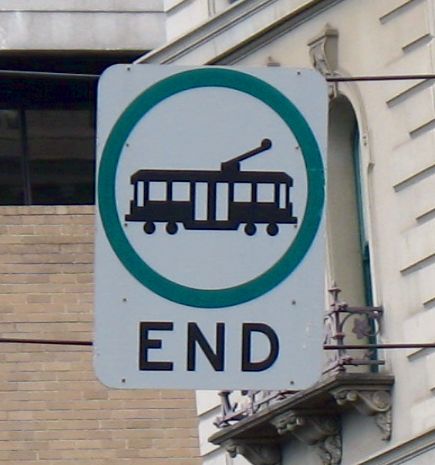 Australia may not be the best country for those who think
freeways ought to go everywhere, because Australia seems to have put
in freeways and toll roads only where they're absolutely needed. But
I'm not a person who thinks freeways ought to go everywhere -- in
fact, I think some urban freeways ought to be torn out. It's a big
country with some big challenges that it's mostly met successfully. I
think we can learn a thing or two from Australia.
Australia may not be the best country for those who think
freeways ought to go everywhere, because Australia seems to have put
in freeways and toll roads only where they're absolutely needed. But
I'm not a person who thinks freeways ought to go everywhere -- in
fact, I think some urban freeways ought to be torn out. It's a big
country with some big challenges that it's mostly met successfully. I
think we can learn a thing or two from Australia.
It was time to go home, but our time in Australia was too short, absolutely too short. I'm sure we'll be back.
Right: Sign mounted on trolley overhead support wires in the Melbourne CBD, indicating the end of trolley tracks in a lane. Below: Sign indicating the end of road work on The Esplanade in the Melbourne beachside suburb of St Kilda. In the background, you can see the old-style roller coaster at the equally old-style amusement park, Luna Park.
